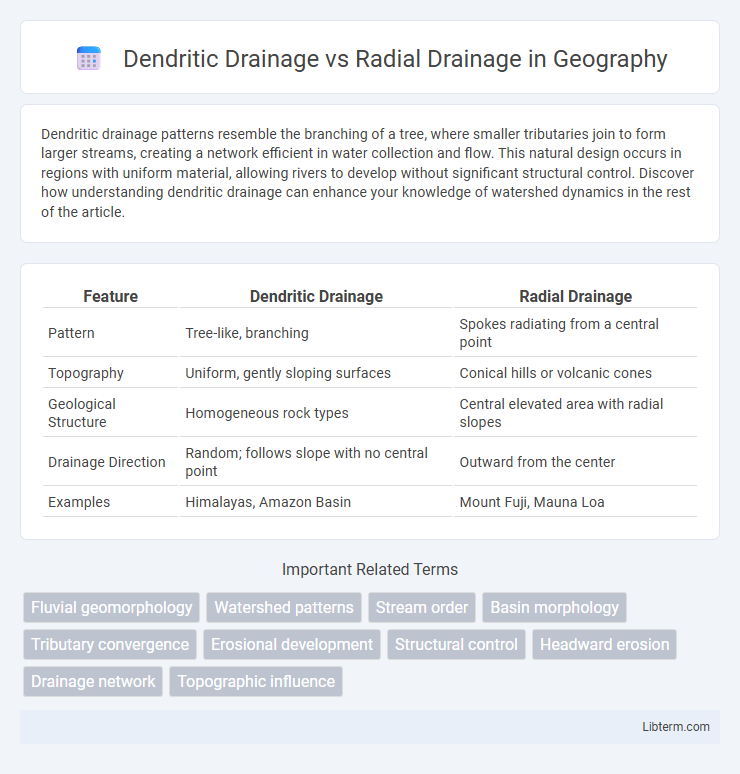Dendritic drainage patterns resemble the branching of a tree, where smaller tributaries join to form larger streams, creating a network efficient in water collection and flow. This natural design occurs in regions with uniform material, allowing rivers to develop without significant structural control. Discover how understanding dendritic drainage can enhance your knowledge of watershed dynamics in the rest of the article.
Table of Comparison
| Feature | Dendritic Drainage | Radial Drainage |
|---|---|---|
| Pattern | Tree-like, branching | Spokes radiating from a central point |
| Topography | Uniform, gently sloping surfaces | Conical hills or volcanic cones |
| Geological Structure | Homogeneous rock types | Central elevated area with radial slopes |
| Drainage Direction | Random; follows slope with no central point | Outward from the center |
| Examples | Himalayas, Amazon Basin | Mount Fuji, Mauna Loa |
Introduction to Drainage Patterns
Dendritic drainage patterns resemble the branching of tree limbs, where tributaries join larger streams at acute angles, commonly forming on homogeneous substrates with uniform resistance. Radial drainage patterns develop when streams flow outward from a central elevated point, such as a volcano or dome, creating a wheel-like formation. These distinct drainage patterns reflect underlying geological structures and influence surface water flow and watershed management.
What is Dendritic Drainage?
Dendritic drainage is a common drainage pattern characterized by tree-like branching of streams and rivers that develop on relatively uniform substrate without structural control. This pattern resembles the veins of a leaf, where smaller tributaries join larger streams at acute angles, allowing efficient water collection and flow. Dendritic drainage typically forms in regions with homogeneous rock types and gentle slopes, maximizing surface runoff connectivity.
What is Radial Drainage?
Radial drainage is a pattern where rivers flow outward from a central elevated point, such as a volcano or dome-shaped hill, resembling the spokes of a wheel. This drainage system contrasts with dendritic drainage, which has a branching, tree-like network formed on uniform substrate without a central peak. Radial drainage often indicates volcanic or dome geology, influencing water flow direction and erosion patterns.
Formation Processes of Dendritic Drainage
Dendritic drainage systems form primarily on relatively flat-lying or uniformly resistant rock structures where streams develop randomly without structural control, creating a tree-like branching pattern. This system evolves as water flows over a homogenous substrate, eroding channels according to surface slope and water flow, resulting in numerous tributaries joining main streams at acute angles. Unlike radial drainage, which develops around conical landforms like volcanoes, dendritic drainage reflects the surface lithology and gradient rather than topographic highs.
Formation Processes of Radial Drainage
Radial drainage systems form when streams flow outward from a central elevated point such as a volcanic cone or dome, where the slope radiates away in all directions. This drainage pattern develops due to the symmetrical and uniform gradient surrounding the peak, guiding rivers to diverge radially. Unlike dendritic drainage, which follows irregular branching influenced by rock resistance, radial drainage directly reflects topographical highs directing water dispersal.
Key Differences Between Dendritic and Radial Drainage
Dendritic drainage patterns exhibit a tree-like branching structure where tributaries join larger streams at acute angles, typically forming on uniform, flat, or gently sloping terrain. Radial drainage patterns radiate outward from a central high point, such as a volcano or dome, with streams flowing away in all directions. The key difference lies in their formation: dendritic patterns develop on homogeneous rock without structural control, while radial patterns are strongly influenced by topographic highs creating centrifugal flow.
Examples of Dendritic Drainage Systems
Dendritic drainage systems are characterized by their tree-like branching patterns, resembling the veins of a leaf, and commonly develop on uniform, flat-lying sedimentary rocks, as seen in the Mississippi River Basin in the United States and the Amazon River Basin in South America. In contrast, radial drainage patterns form around central elevated points such as volcanic cones or domes, exemplified by the drainage around Mount Rainier in Washington and the Masaya Volcano in Nicaragua. The extensive and intricate network of tributaries in dendritic drainage optimizes water collection over large, homogeneous areas, differentiating it from the radial system's outward flow from a single peak.
Examples of Radial Drainage Systems
Radial drainage systems typically develop around volcanic cones or domes, where water flows outward in all directions from a central elevated point. Notable examples of radial drainage include the drainage basins surrounding Mount Fuji in Japan, the Fuji volcano's radial streams extending down its slopes, and the Grand Mesa in Colorado, USA, where rivers radiate from the plateau's summit. These patterns contrast with dendritic drainage systems, which resemble tree branches and commonly form on uniform landscapes without a central high point.
Geographical Distribution and Significance
Dendritic drainage patterns are widely distributed across regions with homogeneous rock types, such as the Great Plains of the United States, where their tree-like branching maximizes surface runoff efficiency. Radial drainage systems predominantly form around volcanic cones and dome-shaped uplands like Mount Fuji in Japan, enabling water to flow outward evenly in all directions. These drainage types are significant in hydrological studies for predicting water flow, sediment transport, and managing watershed resources effectively in diverse geological settings.
Conclusion: Choosing Between Dendritic and Radial Drainage
Choosing between dendritic and radial drainage depends on the landscape and underlying geology; dendritic drainage forms on uniform, flat-lying rocks creating tree-like patterns, while radial drainage develops around a central elevated point such as a volcano or dome. Dendritic systems optimize water flow through efficient branching suited for plains and plateaus, whereas radial systems facilitate outward drainage from hilltops or mountains. Understanding these patterns aids in environmental planning, watershed management, and predicting erosion or sediment transport.
Dendritic Drainage Infographic

 libterm.com
libterm.com